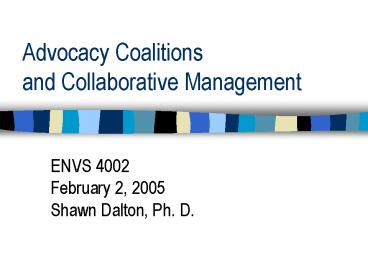Advocacy Coalitions and Collaborative Management - PowerPoint PPT Presentation
1 / 15
Title:
Advocacy Coalitions and Collaborative Management
Description:
Public policies can be conceptualized as belief systems ... Respect for others' core beliefs. Building common vocabulary and culture ... – PowerPoint PPT presentation
Number of Views:539
Avg rating:3.0/5.0
Title: Advocacy Coalitions and Collaborative Management
1
Advocacy Coalitionsand Collaborative Management
- ENVS 4002
- February 2, 2005
- Shawn Dalton, Ph. D.
2
Review
- Environmental problem
- Stakeholder
- Solution
- Barriers to participation
- UNB woodlot example is there an existing or
potential environmental problem?
3
Textbook approach to policy analysis
- Problem identification
- Agenda setting
- Adoption
- Implementation
- Policy evaluation
4
Shortfalls of Textbook Approach
- Not causal model (cant predict process)
- No basis for empirical hypothesis testing
- Descriptive inadequacy (policy process is
non-linear) - Legalistic, top-down focus (policy often driven
by local, bottom-up process) - Policy cycle is temporal unit of analysis
- Does not account for policy-oriented learning
- Does not evaluate effectiveness of policy clean
air, clean water, social justice, e.g.
5
Alternative Advocacy Coalition Framework (3
components)
- Advocacy coalition actors from a variety of
public and private institutions at all levels of
government who share a set of basic beliefs, and
who seek to manipulate the rules, budgets, and
personnel of governmental institutions in order
to achieve these goals over time
6
- External Changes Changes external to the
subsystem in socioeconomic conditions,
system-wide governing coalitions, and output from
other subsystems that provide opportunities and
obstacles to the competing coalitions
7
- Stable system parameters those parameters, such
as social structure and constitutional rules,
that place constraints and resources on the
various subsystem actors
8
Premises
- Understanding policy change requires a time
perspective of at least a decade - Focus on policy subsystems most useful approach
- Must include intergovernmental dimension
- Public policies can be conceptualized as belief
systems
9
Understanding policy change requires a time
perspective of at least a decade
- Initial successes sometimes fizzle
- What appear to be failures initially can be
enduring successes over time - Need enough time to determine whether policy has
desired effects, plus identify collateral
benefits/damage
10
Focus on policy subsystems most useful approach
- Policy subsystem those actors from a variety of
public and private organizations who are actively
concerned with a policy problem or issue
11
Must include intergovernmental dimension
- Interactions among all levels of government must
be evaluated in order to understand or interpret
fate of policy frameworks
12
Belief Systems
- Public policies can be conceptualized as belief
systems - Deep core (fundamental normative)
non-negotiable - Core (fundamental policy positions concerning
basic strategies for achieving deep core beliefs)
difficult, but possible to change, given
information/experience - Secondary (instrumental decisions and information
searches necessary to implement policy core)
moderately easy to change
13
ACF Applications in Collaborative Resource
Management?
- Policy-oriented learning in collaboration
- Shared vocabulary
- Science as common language???
- Collaborative initiatives require
- Shared control and decision-making
- Innovation and creativity
- Respect for others core beliefs
- Building common vocabulary and culture
- Mechanisms for dealing with conflict
14
Collaborative Management
- Why collaborate?
- Critical to ecosystem management approach,
landscapes are fragmented geographically,
politically, and by ownership - Part of life in a diverse society
- Can produce better decisions than adversarial
approaches - Improves chances of implementation
15
Key Lessons
- Focus on the problem
- Partnerships are people
- Entrepreneurial approach






























